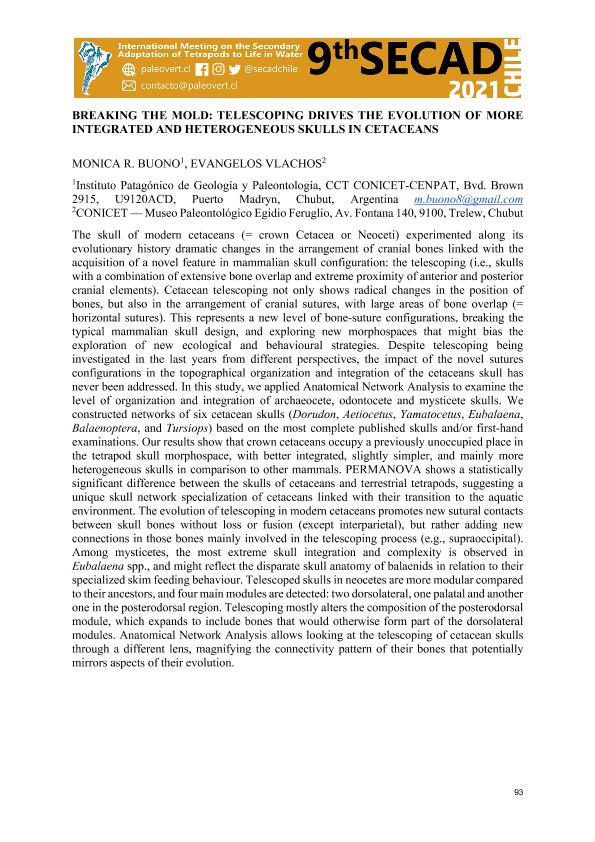Mostrar el registro sencillo del ítem
dc.contributor.author
Buono, Mónica Romina

dc.contributor.author
Vlachos, Evangelos

dc.date.available
2022-10-11T14:19:43Z
dc.date.issued
2021
dc.identifier.citation
Breaking the mold: Telescoping drives the evolution of more integrated and heterogeneous skulls in cetaceans; 9th International Meeting on the Secondary Adaptation of Tetrapods to Life in Water; San Vicente de Tagua Tagua; Chile; 2021; 93-93
dc.identifier.uri
http://hdl.handle.net/11336/172491
dc.description.abstract
The skull of modern cetaceans (= crown Cetacea or Neoceti) experimented along its evolutionary history dramatic changes in the arrangement of cranial bones linked with the acquisition of a novel feature in mammalian skull configuration: the telescoping (i.e., skulls with a combination of extensive bone overlap and extreme proximity of anterior and posterior cranial elements). Cetacean telescoping not only shows radical changes in the position of bones, but also in the arrangement of cranial sutures, with large areas of bone overlap (= horizontal sutures). This represents a new level of bone-suture configurations, breaking the typical mammalian skull design, and exploring new morphospaces that might bias the exploration of new ecological and behavioural strategies. Despite telescoping being investigated in the last years from different perspectives, the impact of the novel sutures configurations in the topographical organization and integration of the cetaceans skull has never been addressed. In this study, we applied Anatomical Network Analysis to examine the level of organization and integration of archaeocete, odontocete and mysticete skulls. We constructed networks of six cetacean skulls (Dorudon, Aetiocetus, Yamatocetus, Eubalaena, Balaenoptera, and Tursiops) based on the most complete published skulls and/or first-hand examinations. Our results show that crown cetaceans occupy a previously unoccupied place in the tetrapod skull morphospace, with better integrated, slightly simpler, and mainly more heterogeneous skulls in comparison to other mammals. PERMANOVA shows a statistically significant difference between the skulls of cetaceans and terrestrial tetrapods, suggesting a unique skull network specialization of cetaceans linked with their transition to the aquatic environment. The evolution of telescoping in modern cetaceans promotes new sutural contacts between skull bones without loss or fusion (except interparietal), but rather adding new connections in those bones mainly involved in the telescoping process (e.g., supraoccipital). Among mysticetes, the most extreme skull integration and complexity is observed in Eubalaena spp., and might reflect the disparate skull anatomy of balaenids in relation to their specialized skim feeding behaviour. Telescoped skulls in neocetes are more modular compared to their ancestors, and four main modules are detected: two dorsolateral, one palatal and another one in the posterodorsal region. Telescoping mostly alters the composition of the posterodorsal module, which expands to include bones that would otherwise form part of the dorsolateral modules. Anatomical Network Analysis allows looking at the telescoping of cetacean skulls through a different lens, magnifying the connectivity pattern of their bones that potentially mirrors aspects of their evolution.
dc.format
application/pdf
dc.language.iso
eng
dc.publisher
Secondary Adaptation of Tetrapods to Life in Water
dc.rights
info:eu-repo/semantics/openAccess
dc.rights.uri
https://creativecommons.org/licenses/by-nc-sa/2.5/ar/
dc.subject
CONNECTIVITY PATTERN
dc.subject
SUTURES
dc.subject
NEOCETI
dc.subject
ANATOMICAL NETWORKS
dc.subject.classification
Paleontología

dc.subject.classification
Ciencias de la Tierra y relacionadas con el Medio Ambiente

dc.subject.classification
CIENCIAS NATURALES Y EXACTAS

dc.title
Breaking the mold: Telescoping drives the evolution of more integrated and heterogeneous skulls in cetaceans
dc.type
info:eu-repo/semantics/publishedVersion
dc.type
info:eu-repo/semantics/conferenceObject
dc.type
info:ar-repo/semantics/documento de conferencia
dc.date.updated
2022-09-15T11:21:07Z
dc.journal.pagination
93-93
dc.journal.pais
Chile

dc.journal.ciudad
San Vicente de Tagua Tagua
dc.description.fil
Fil: Buono, Mónica Romina. Consejo Nacional de Investigaciones Científicas y Técnicas. Centro Científico Tecnológico Conicet - Centro Nacional Patagónico. Instituto Patagónico de Geología y Paleontología; Argentina
dc.description.fil
Fil: Vlachos, Evangelos. Consejo Nacional de Investigaciones Científicas y Técnicas; Argentina. Museo Paleontológico Egidio Feruglio; Argentina
dc.relation.alternativeid
info:eu-repo/semantics/altIdentifier/url/https://rid.unrn.edu.ar/bitstream/20.500.12049/8314/1/Abstracts%20Book%209th%20SECAD%20Chile%202021%20%281%29.pdf
dc.conicet.rol
Autor

dc.conicet.rol
Autor

dc.coverage
Internacional
dc.type.subtype
Encuentro
dc.description.nombreEvento
9th International Meeting on the Secondary Adaptation of Tetrapods to Life in Water
dc.date.evento
2021-04-19
dc.description.ciudadEvento
San Vicente de Tagua Tagua
dc.description.paisEvento
Chile

dc.type.publicacion
Book
dc.description.institucionOrganizadora
Asociación Paleontológica Argentina
dc.description.institucionOrganizadora
Asociación Chilena de Paleontología
dc.source.libro
Abstract Book-9th International Meeting on the Secondary Adaptation of Tetrapods to Life in Water
dc.date.eventoHasta
2021-04-23
dc.type
Encuentro
Archivos asociados
